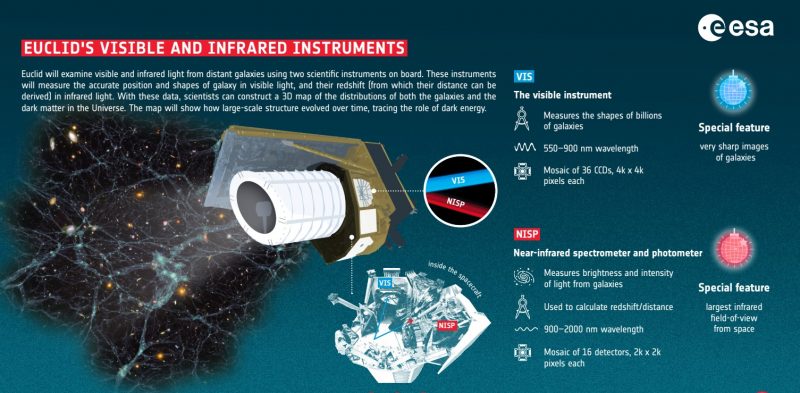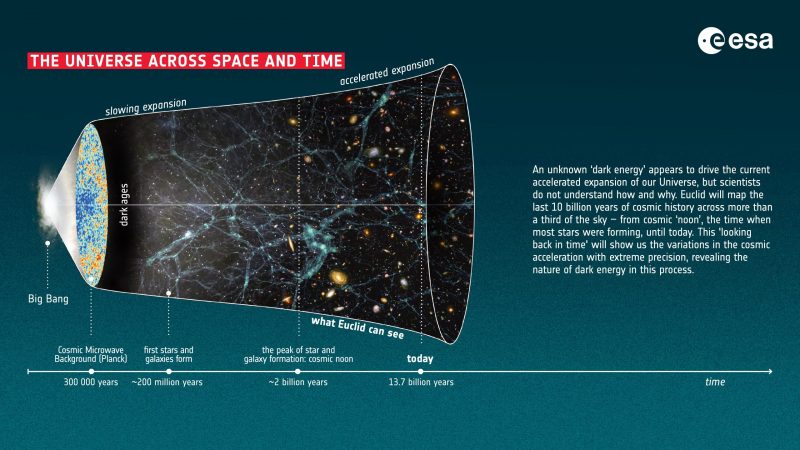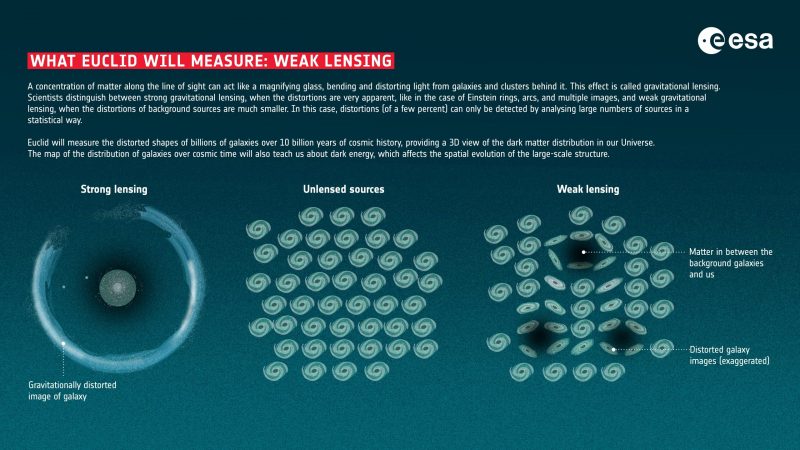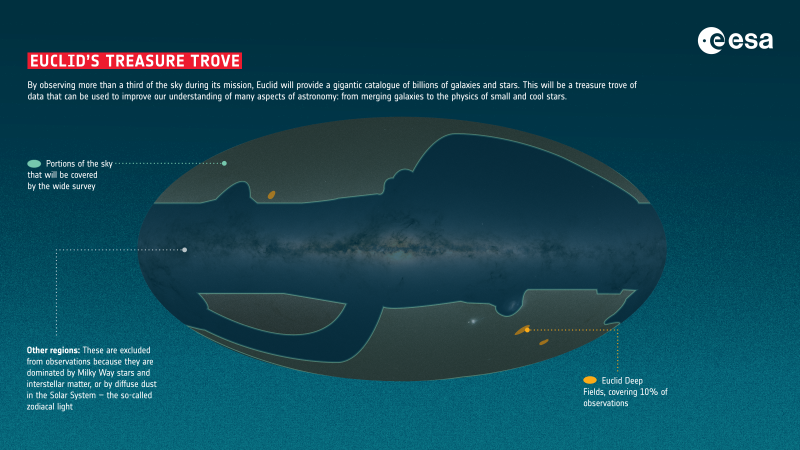
The European Space Agency (ESA) has a new mission, Euclid, set to explore the dark universe. Euclid is named after an ancient Greek mathematician. It launched successfully from Cape Canaveral, Florida, today at 11:12 EDT (July 1, 2023). The mission’s goal is to create the largest, most accurate 3D map of our universe. Also, scientists will use it to observe galaxies out to 10 billion light-years, covering more than 1/3 of the sky. These observations should help astronomers to better understand the universe’s expansion and structure over time, providing insight to the nature of dark matter and dark energy.
Dark matter and dark energy are two huge fundamental holes in our understanding of the universe. Dark matter makes up about 25% of the universe, but we don’t know what it is. Moreover, we only know it exists because we can see the effects it has on other objects. And nearly 70% of the universe seems to be made of dark energy, an unknown force that is causing the universe to expand. (A recent study said perhaps black holes are the source of dark energy.) That leaves the ordinary matter we see – stars and galaxies, etc. – as only about 5% of the universe.

The launch
Euclid launched on a Falcon 9 rocket at 11:12 EDT on July 1, 2023. ESA called the launch a success after the Euclid spacecraft separated from the second stage of a SpaceX Falcon 9 rocket. You can watch a replay of the launch below.
Euclid mission will reside at L2
The Euclid spacecraft will travel to its future home at the sun-Earth Lagrange point 2. By the way, Lagrange point 2 is 930,000 miles (1.5 million km) from Earth. You may be familiar with it as the home of the Webb space telescope. The L2 position allows a spacecraft to be close enough to communicate with Earth, receive enough solar power, and still peer into deep space.
Instruments onboard
Euclid will carry two science instruments. The first is a visible-wavelength camera, or VIS. Also, it will carry a near-infrared spectrometer and photometer, or NISP. Therefore, Euclid should provide excellent quality imaging in visible wavelengths, plus spectroscopy and photometry in near-infrared. Learn more about Euclid’s instruments in the illustration below.

A quest to answer 5 mysteries
Euclid is looking to address five mysteries:
- What is the structure and history of the cosmic web?
- What is the nature of dark matter?
- How has the expansion of the universe changed over time?
- What is the nature of dark energy?
- Is our understanding of gravity complete?
When will Euclid begin mapping?
Euclid should arrive in L2 orbit about four weeks after launch. Then, for about three months, the instruments will go through a testing phase. Finally, Euclid should be ready to survey the universe around three months from now.
What will the Euclid mission see and measure?




Bottom line: ESA’s Euclid mission will travel to its home at L2, where it will make a 3D map of the universe. And scientists hope to use its observations to learn more about dark matter and dark energy.
The post Euclid mission launches: Will study dark matter and energy first appeared on EarthSky.
from EarthSky https://ift.tt/cAtkMD2

The European Space Agency (ESA) has a new mission, Euclid, set to explore the dark universe. Euclid is named after an ancient Greek mathematician. It launched successfully from Cape Canaveral, Florida, today at 11:12 EDT (July 1, 2023). The mission’s goal is to create the largest, most accurate 3D map of our universe. Also, scientists will use it to observe galaxies out to 10 billion light-years, covering more than 1/3 of the sky. These observations should help astronomers to better understand the universe’s expansion and structure over time, providing insight to the nature of dark matter and dark energy.
Dark matter and dark energy are two huge fundamental holes in our understanding of the universe. Dark matter makes up about 25% of the universe, but we don’t know what it is. Moreover, we only know it exists because we can see the effects it has on other objects. And nearly 70% of the universe seems to be made of dark energy, an unknown force that is causing the universe to expand. (A recent study said perhaps black holes are the source of dark energy.) That leaves the ordinary matter we see – stars and galaxies, etc. – as only about 5% of the universe.

The launch
Euclid launched on a Falcon 9 rocket at 11:12 EDT on July 1, 2023. ESA called the launch a success after the Euclid spacecraft separated from the second stage of a SpaceX Falcon 9 rocket. You can watch a replay of the launch below.
Euclid mission will reside at L2
The Euclid spacecraft will travel to its future home at the sun-Earth Lagrange point 2. By the way, Lagrange point 2 is 930,000 miles (1.5 million km) from Earth. You may be familiar with it as the home of the Webb space telescope. The L2 position allows a spacecraft to be close enough to communicate with Earth, receive enough solar power, and still peer into deep space.
Instruments onboard
Euclid will carry two science instruments. The first is a visible-wavelength camera, or VIS. Also, it will carry a near-infrared spectrometer and photometer, or NISP. Therefore, Euclid should provide excellent quality imaging in visible wavelengths, plus spectroscopy and photometry in near-infrared. Learn more about Euclid’s instruments in the illustration below.

A quest to answer 5 mysteries
Euclid is looking to address five mysteries:
- What is the structure and history of the cosmic web?
- What is the nature of dark matter?
- How has the expansion of the universe changed over time?
- What is the nature of dark energy?
- Is our understanding of gravity complete?
When will Euclid begin mapping?
Euclid should arrive in L2 orbit about four weeks after launch. Then, for about three months, the instruments will go through a testing phase. Finally, Euclid should be ready to survey the universe around three months from now.
What will the Euclid mission see and measure?




Bottom line: ESA’s Euclid mission will travel to its home at L2, where it will make a 3D map of the universe. And scientists hope to use its observations to learn more about dark matter and dark energy.
The post Euclid mission launches: Will study dark matter and energy first appeared on EarthSky.
from EarthSky https://ift.tt/cAtkMD2

Aucun commentaire:
Enregistrer un commentaire